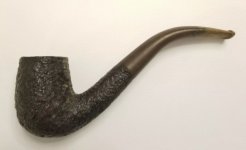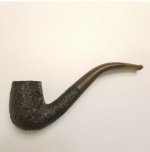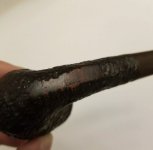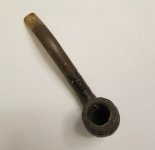I’m thinking of buying this. It’s hidden in a lot of pipes for sale and the seller sent me these additional photos. Can anyone identify the year range based on what little information available? Also, I’m trying to figure out the shape.
Dating A Buffed Dunhill
- Thread starter bayareabriar
- Start date
You are using an out of date browser. It may not display this or other websites correctly.
You should upgrade or use an alternative browser.
You should upgrade or use an alternative browser.
SmokingPipes.com Updates
Watch for Updates Twice a Week
It looks like a Dunhill 56 but not sure. Something is off. Can you post up the actual nomenclature? I see a Canadian patent, but no other nomenclature. The walls on the bowl seem extra thick but the pictures are pretty bad....
Took them into Photoshop, but the information just isn't there. You might have better luck if you end up buying it and can get it under a jeweler's loupe with a good light source.
Thank you! Sometimes the angle reveals better stampingTook them into Photoshop, but the information just isn't there. You might have better luck if you end up buying it and can get it under a jeweler's loupe with a good light source.
I've heard that the Canadian patents were made by Blatter and Blatter during WWII.
I’ve chatted with them a few times. I know their dad made pipes at his kitchen table while the kids ran around the house in the 50s. (Kids now run it). I don’t know if they could make the volume needed. I’ll give them a call this week and see if they have any insight. InterestingI've heard that the Canadian patents were made by Blatter and Blatter during WWII.
I just talked with Patrick Blatter. He did say that during WW2 his great grandfather had a pipe factory and they made the Canadian patent pipes for Dunhill. He said they made pipes for others too. He said that they were really good at making certain shapes for Dunhill hence the Canadian patent.I've heard that the Canadian patents were made by Blatter and Blatter during WWII.
Now the question: are most Dunhill Canadian patents of similar shapes?
The take home lesson is, don't buff your pipes, or at least not with a high rpm machine. Actually, much can be done by hand with a slightly abrasive and then a soft cloth, like a jeweler's cloth. brad smith uses a shoe buffer, with a fairly soft buffing brush, and that probably does no damage. I think by hand is best, leaving the stamps intact. Why the stamps don't give more direct pertinent information is another trope for another thread.
Even with heavy buffing duly noted (apparently obliterating one side of the shank but not the othe), the nomenclature is definitely a bit weird (which happens). For instance, it is difficult to imagine quite where the actual full Canada patent number could have appeared (since the number 2 is right at the edge of the sandblast), whatever one's guess might be about what was buffed away.
According to Loring (page 59) all Canada shell patents begin with the number two, with a date range of 1928-1941.
As for shape, a blurry "56" (with what would have been a number for the appropriate innertube) is there. And at least to me, it looks pretty typical for a 56--which varied a good deal over the very long period they were made, between smooth and sandblasted models, and even among individual examples of a period.
Good hunting!
According to Loring (page 59) all Canada shell patents begin with the number two, with a date range of 1928-1941.
As for shape, a blurry "56" (with what would have been a number for the appropriate innertube) is there. And at least to me, it looks pretty typical for a 56--which varied a good deal over the very long period they were made, between smooth and sandblasted models, and even among individual examples of a period.
Good hunting!
Yeah I noticed that too as for as the 2 and where is there room for the patent?Even with heavy buffing duly noted (apparently obliterating one side of the shank but not the othe), the nomenclature is definitely a bit weird (which happens). For instance, it is difficult to imagine quite where the actual full Canada patent number could have appeared (since the number 2 is right at the edge of the sandblast), whatever one's guess might be about what was buffed away.
According to Loring (page 59) all Canada shell patents begin with the number two, with a date range of 1928-1941.
As for shape, a blurry "56" (with what would have been a number for the appropriate innertube) is there. And at least to me, it looks pretty typical for a 56--which varied a good deal over the very long period they were made, between smooth and sandblasted models, and even among individual examples of a period.
Good hunting!
Have him email the photos! Screen shots lack detail and cannot be successfully enlargedthanks guys. It’s photos I screenshotted from seller. I’ll try to post some in-zoomed in ones.
I'm no expert on Dunhill markings but it seems odd that so much of the stamping is buffed away and the "Canadian Patent" is so clear.
It definitely stands out. But it doesn’t not appear to be a dunhillI'm no expert on Dunhill markings but it seems odd that so much of the stamping is buffed away and the "Canadian Patent" is so clear.
I would tend to agree but the shape is a dead ringer for a "Swan Neck" 56...It definitely stands out. But it doesn’t not appear to be a dunhill














